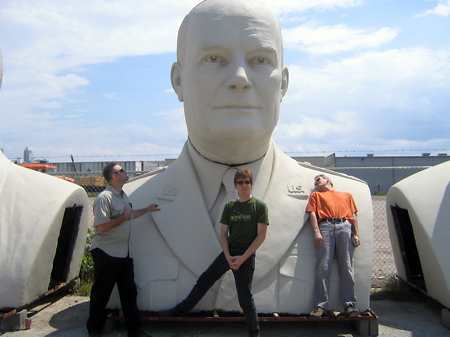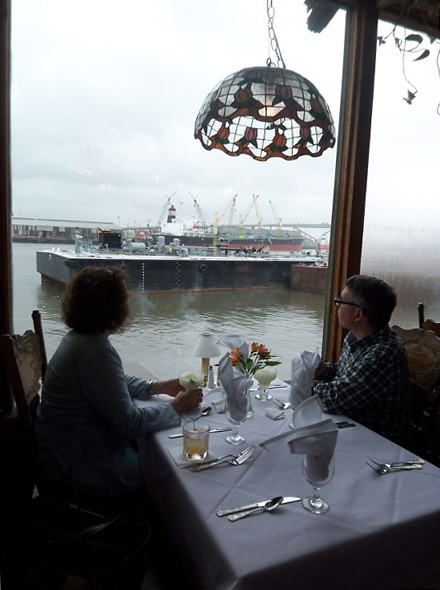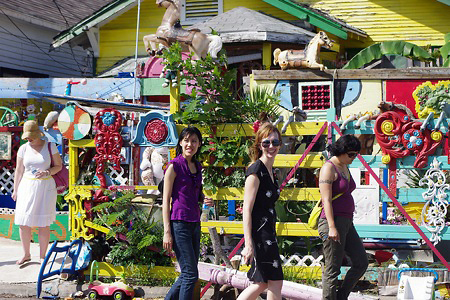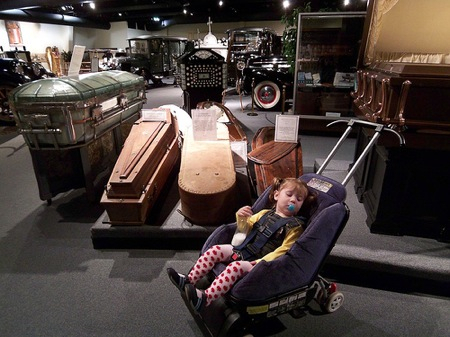During the ten years that I was with Aurora Picture Show, I hosted at least 300 visiting artists, and gave almost that many tours of Houston. Like an old cabbie, I have fine-tuned these trips into a scripted tour that features folk art environments, underground tunnels, celebrity grave sites, art cars, urban bayous, museums, mega churches, and art chapels. Imagine my gravelly voice coming through an old p.a. system as I humbly present to you, “Grover’s Guide to Houston, Part I.”
Big Heads of Presidents (2500 Summer Street)
David Adickes is best known for his monumental scale public sculptures like the giant cement Sam Houston erected on the side of I-45 in Huntsville, Texas. For the last ten years or so, Adickes has been working on two separate commissions of gargantuan Presidential busts for patriotic theme parks (namely, President’s Park in Lead, South Dakota and Waterlights District Presidential Park and Gardens in Pearland, Texas). Several of the 20’+ cement busts are installed around the parking lot of Adickes’ studio in an industrial-turned-shopping-center neighborhood of Houston. I like to play “Name that President” with my tour groups.
Brady’s Landing (8505 Cypress Street)
Only in Houston would a restaurant on the industrial Houston Ship Channel be considered picturesque. The view from Brady’s Landing is that of the second largest port in the U.S., with tankers, cargo containers, and petrochemical complexes crisscrossing the horizon. A field stone fireplace burns year-round in the foyer, regardless of the subtropical temperatures outside. Denial is always in season at Brady’s Landing, which specializes in Gulf seafood.
Flower Man House (3317 Sampson Street)
Cleveland Turner, aka “The Flower Man” began creating his glittery, trash-studded home after nearly dying in 1983 of an alcoholic coma that put him off Thunderbird for life. The 70-something year old native of Mississippi welcomes visitors to see his installation of dolls, toys, and other found junk, or visit his backyard with 50 year-old canned preserves, cotton plants, chickens and guineas. He patiently repeats the story of his “Skid Row” days, and his near-death vision of a tornado of colorful garbage that became the inspiration for his home. My favorite part of the Flower Man House, besides Mr. Turner himself, is the lumpy carpeted sidewalks.
Howard Hughes’ Grave (2525 Washington Avenue)
So what if he locked himself in a movie studio theater for over four months, subsisting only on chocolate bars and milk and defecating in empty containers? Howard Hughes was a brilliant aviator, engineer, movie producer, director and philanthropist, whose eccentric behavior overshadowed his more "normal" accomplishments, like building Houston’s first radio transmittor when he was 11-years old. Glenwood Cemetery is Hughes’ final resting place, and the home to Houston’s most alive Live Oaks.
Lakewood Church (3700 Southwest Freeway)
Lakewood is the largest mega-church in the U.S., housed in a former sports arena with seating for about 15,000. Pastor Joel Osteen, the impresario behind Lakewood’s success, insists on services with high production value and designer theatrical elements. A million dollar lighting grid that was modeled after Hollywood award shows, three giant LCD screens, piped in fog, waterfalls, and an opening musical act make Lakewood’ services feel more like a rock concert than a sermon. The onsite television and music recording studio produces Osteen’s weekly television ministry, and free babysitting is provided in a Disney-esque, Bible-themed amusement area.
National Museum of Funeral History (415 Barren Springs Drive)
Their slogan is "Any day above ground is a good one." You would never suspect that such wit and wisdom about death resides inside the walls of this non-descript industrial park building. Among my favorite items on exhibit is a three-person suicide coffin, which was commissioned by a couple who lost their child and intended to commit suicide, but came to their senses and never picked up the coffin (sticking the coffin-maker with the massive box and the massive bill). As a nautical gal, I also greatly admire the Evinrude Motor-shaped coffin from Ghana, where coffins are made to look like the material possessions one desired (but did not obtain) in this mortal coil.
Coming soon: Grover’s Guide to Houston, Part II









